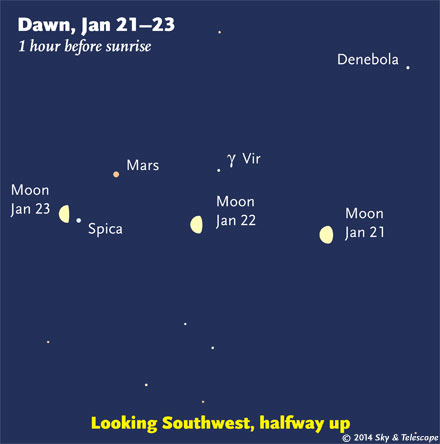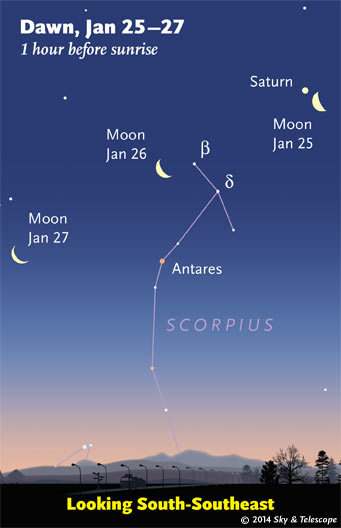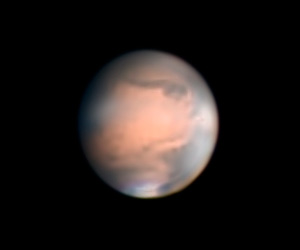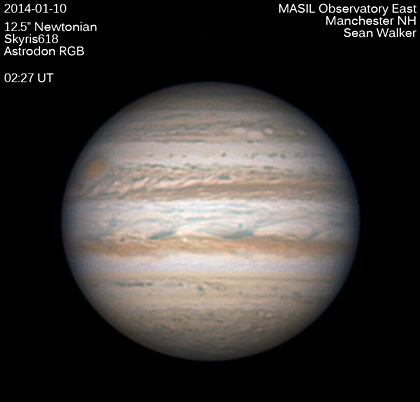Supernova in M82! On Tuesday January 21st astronomers first noticed an 11th-magnitude supernova in the galaxy M82 in Ursa Major. It's in the evening sky in reach of amateur telescopes, and it may not be done brightening yet. See our article, Bright Supernova in M82.
Friday, January 17
Saturday, January 18
Sunday, January 19
Monday, January 20

Look southwest before dawn Wednesday and Thursday for the Moon grouping up with Mars and Spica. (These scenes are drawn for the middle of North America. European observers: move each Moon a quarter of the way toward the one for the previous date. The Moon is shown three times actual size.)
Tuesday, January 21
Wednesday, January 22
Thursday, January 23
Friday, January 24

Waning further, the dawn Moon now passes Saturn and Antares. (The Moon is shown three times actual size.)
Alan MacRobert
Saturday, January 25
Want to become a better astronomer? Learn your way around the constellations. They're the key to locating everything fainter and deeper to hunt with binoculars or a telescope.
This is an outdoor nature hobby. For an easy-to-use constellation guide covering the whole evening sky, use the big monthly map in the center of each issue of Sky & Telescope, the essential guide to astronomy. Or download our free Getting Started in Astronomy booklet (which only has bimonthly maps).

The Pocket Sky Atlas plots 30,796 stars to magnitude 7.6 — which may sound like a lot, but that's less than one star in an entire telescopic field of view, on average. By comparison, Sky Atlas 2000.0 plots 81,312 stars to magnitude 8.5, typically one or two stars per telescopic field. Both atlases include many hundreds of deep-sky targets — galaxies, star clusters, and nebulae — to hunt among the stars.
Sky & Telescope
Once you get a telescope, to put it to good use you'll need a detailed, large-scale sky atlas (set of charts). The standards are the little Pocket Sky Atlas, which shows stars to magnitude 7.6; the larger and deeper Sky Atlas 2000.0 (stars to magnitude 8.5); and once you know your way around, the even larger Uranometria 2000.0 (stars to magnitude 9.75). And read how to use sky charts with a telescope.
You'll also want a good deep-sky guidebook, such as Sue French's Deep-Sky Wonders collection (which includes its own charts), Sky Atlas 2000.0 Companion by Strong and Sinnott, the bigger Night Sky Observer's Guide by Kepple and Sanner, or the beloved if dated Burnham's Celestial Handbook.
Can a computerized telescope replace charts? Not for beginners, I don't think, and not on mounts and tripods that are less than top-quality mechanically (able to point with better than 0.2° repeatability, which means fairly heavy and expensive). As Terence Dickinson and Alan Dyer say in their invaluable Backyard Astronomer's Guide, "A full appreciation of the universe cannot come without developing the skills to find things in the sky and understanding how the sky works. This knowledge comes only by spending time under the stars with star maps in hand."
This Week's Planet Roundup

Gibbous Mars was still just 7.1 arcseconds from pole to pole on January 6th when Don Parker in Florida imaged it with a 16-inch reflector. South is up. Note the North Polar Cap with hints of a rift already developing, morning clouds near the following (celestial east; right-hand) limb, haze visible over the dark Syrtis Major region on the opposite (preceding) limb, and in the south, distinctive Sinus Sabaeus ending with two-pronged Sinus Meridiani.
Donald C. Parker
Mercury (magnitude –0.9) is emerging into twilight view after sunset. Look for it above the west-southwest horizon about 30 to 45 minutes after sunset. It's becoming higher in darker twilight every day.
Venus (about magnitude –4.4) is now plain to see low in early dawn; look east-southeast. It too is becoming higher every day.
In a telescope Venus is a very thin, large crescent following its inferior conjunction on January 11th.
Mars (magnitude +0.5, in Virgo) rises around 11 or midnight. Spica, not quite as bright at magnitude +1.0, rises about 6° below it. They're highest in the south before the first light of dawn, with Spica now to Mars's lower left.
In a telescope Mars is still pretty small, 8 arcseconds wide. It'll be nearly twice this diameter (15.1″) when closest in mid-April.

Jupiter on the night of January 9–10, taken from New Hampshire by S&T's imaging editor Sean Walker. South is up. The Great Red Spot, unusually strong orange this season, is obvious even near the limb. Following (celestial east) of it is a long, diminishing series of white swirls in the South Equatorial Belt. Notice the tight trio of white ovals in the South South Temperate Belt, and the blue festoons in the Equatorial Zone.
S&T: Sean Walker
Jupiter (magnitude –2.7, in Gemini) dominates the eastern sky in the evening and crosses nearly overhead (for mid-northern observers) around 11 p.m.
In a telescope Jupiter remains a big 46 arcseconds wide. For lots about observing Jupiter see the January Sky & Telescope or the brief article online: Jupiter: Big, Bright, and Beautiful.
Saturn (magnitude +0.6, in Libra) rises around 2 a.m. and is well up in the southeast as dawn begins to brighten. By then it's far lower left of Mars and Spica, and even farther below brighter Arcturus.
Uranus (magnitude 5.9, in Pisces) is still well up in the southwest right after dark. Finder chart.
Neptune (magnitude 8.0, in Aquarius) is low in the west-southwest at nightfall.
All descriptions that relate to your horizon — including the words up, down, right, and left — are written for the world's mid-northern latitudes. Descriptions that also depend on longitude (mainly Moon positions) are for North America.
Eastern Standard Time (EST) is Universal Time (UT, UTC, or GMT) minus 5 hours.
Like This Week's Sky at a Glance? Watch our SkyWeek TV short, also playing on PBS.
To be sure to get the current Sky at a Glance, bookmark this URL:
http://SkyandTelescope.com/observing/ataglance?1=1
If pictures fail to load, refresh the page. If they still fail to load, change the 1 at the end of the URL to any other character and try again.
 0
0
Comments
You must be logged in to post a comment.